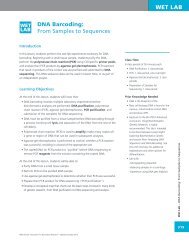LESSON 4 Using Bioinformatics to Analyze Protein Sequences
LESSON 4 Using Bioinformatics to Analyze Protein Sequences
LESSON 4 Using Bioinformatics to Analyze Protein Sequences
You also want an ePaper? Increase the reach of your titles
YUMPU automatically turns print PDFs into web optimized ePapers that Google loves.
<strong>LESSON</strong> 4CLASS SET13. Click on the graph where you seethe longest reading frame. You shouldsee the DNA sequence and translatedprotein appear below the ORF Finderdisplay, as shown in Figure 3.14. How long is this protein (i.e., howmany amino acids)?15. Is the length of the protein similar<strong>to</strong> what you would expect given thelength of the DNA sequence in Step#13 above? Why or why not? [Note:Remember that each codon for oneamino acid is three nucleotides long.]Figure 3: Choosing the <strong>Protein</strong> with the Longest Open Reading Frame.Source: NCBI ORF Finder.PART II: Multiple Sequence Alignments <strong>Using</strong> <strong>Protein</strong> <strong>Sequences</strong>Now that you have the protein sequence translated from your barcode DNA, what can you do with it? Many geneticresearchers compare protein sequences from different species by performing multiple sequence alignments, similar<strong>to</strong> those you made with your DNA sequences in the previous lesson. This makes it possible <strong>to</strong> identify amino acidchanges among species, which can lend insight in<strong>to</strong> the functional consequences of protein evolution.16. Go <strong>to</strong> the Bio-ITEST website and click on theResources tab (gray box, Figure 4): http://www.nwabr.org/curriculum/advanced-bioinformaticsgenetic-research.17. Click on the <strong>Protein</strong> sequences file for your group(black box, Figure 4).18. Copy all of your group’s protein sequences,including the species name and the caret “>.” Eachof these sequences contains the same open readingframe that you identified with ORF Finder in Part I. Besure <strong>to</strong> select and copy all of the sequences.19. Go <strong>to</strong> ClustalW2 at the European <strong>Bioinformatics</strong>Institute (EBI) at: http://www.ebi.ac.uk/Tools/msa/clustalw2/.20. Paste your Group <strong>Protein</strong> sequences in<strong>to</strong> thesequence box in STEP 1 (black arrow, Figure 5).21. Select <strong>Protein</strong> from the drop down menu (blackbox, Figure 5).22. Click Submit (gray arrow, Figure 5).Figure 4: Obtain Your Group <strong>Protein</strong> <strong>Sequences</strong> from the Bio-ITESTResources Page for Advanced <strong>Bioinformatics</strong>. Source: NWABR.Lesson 4 – <strong>Using</strong> <strong>Bioinformatics</strong> <strong>to</strong> <strong>Analyze</strong> <strong>Protein</strong> <strong>Sequences</strong>147©Northwest Association for Biomedical Research—Updated Oc<strong>to</strong>ber 2012
















